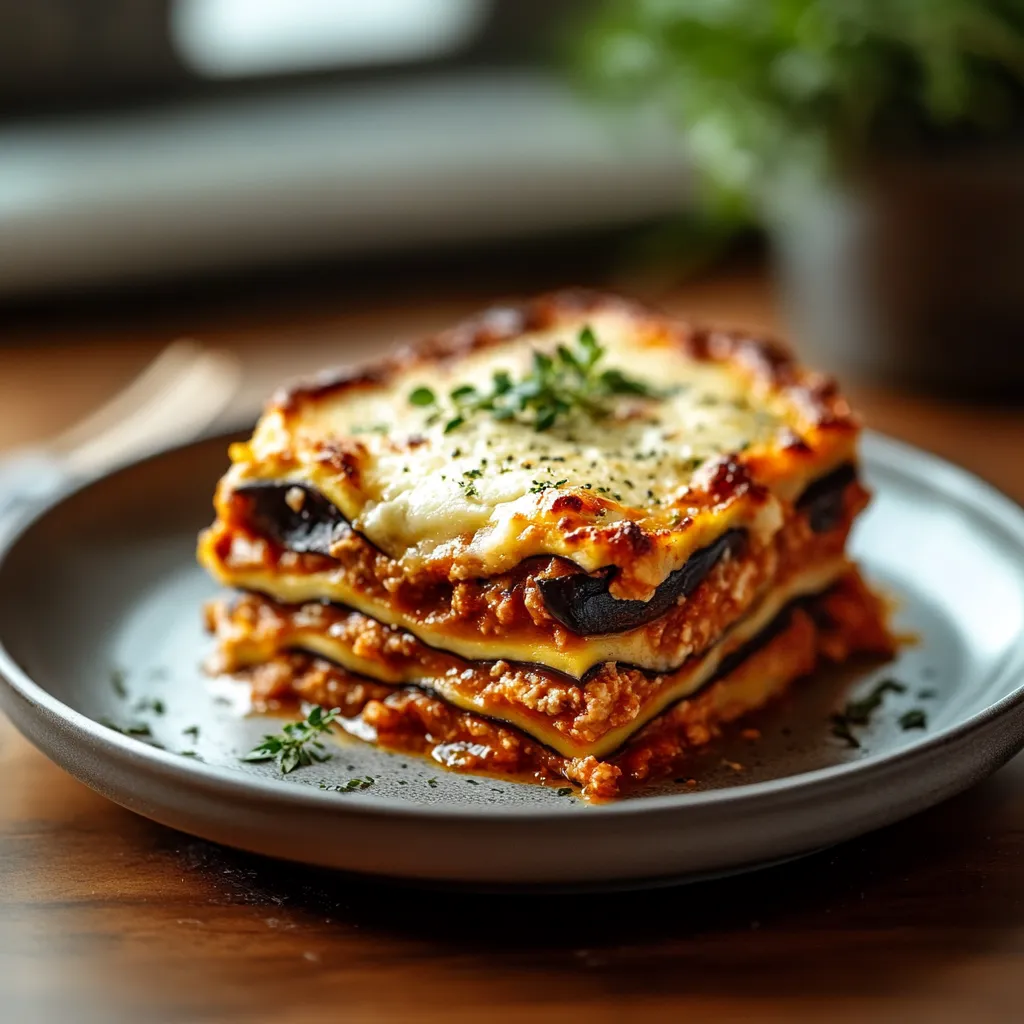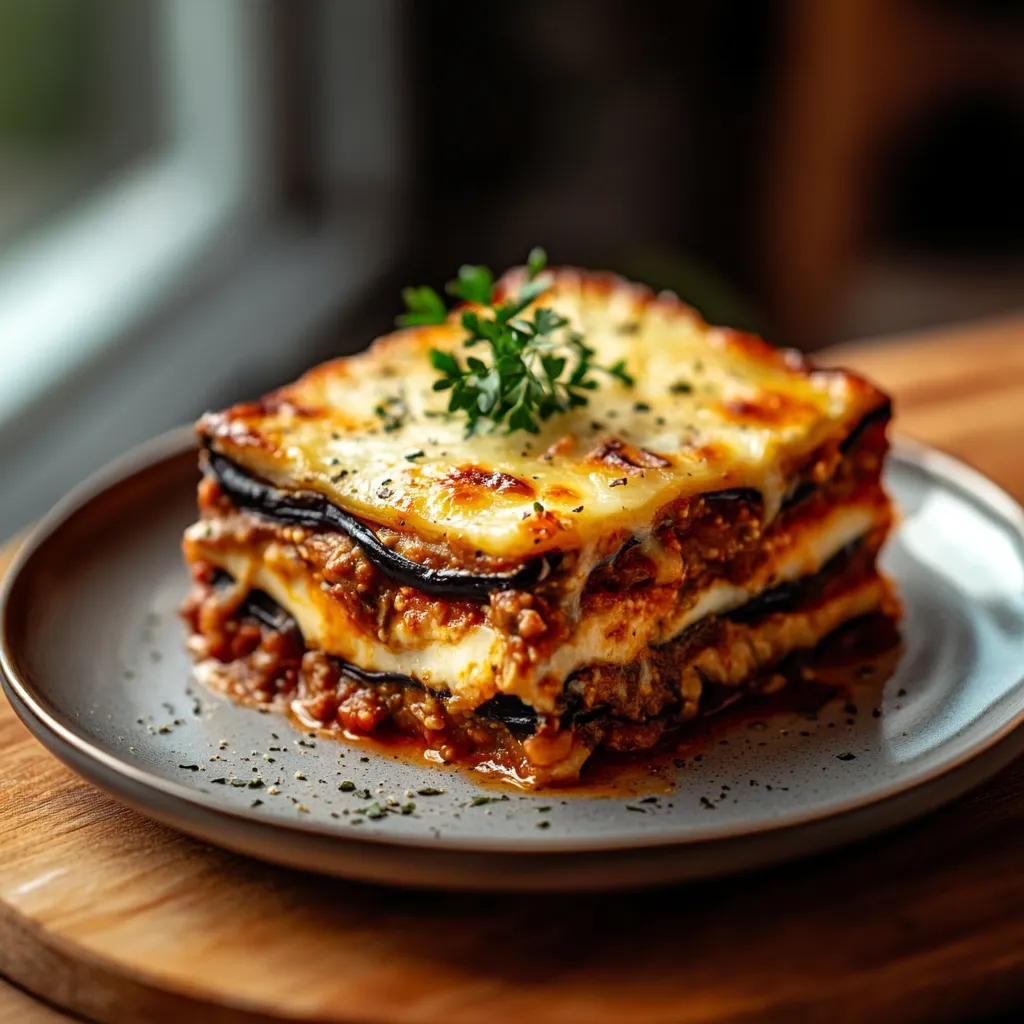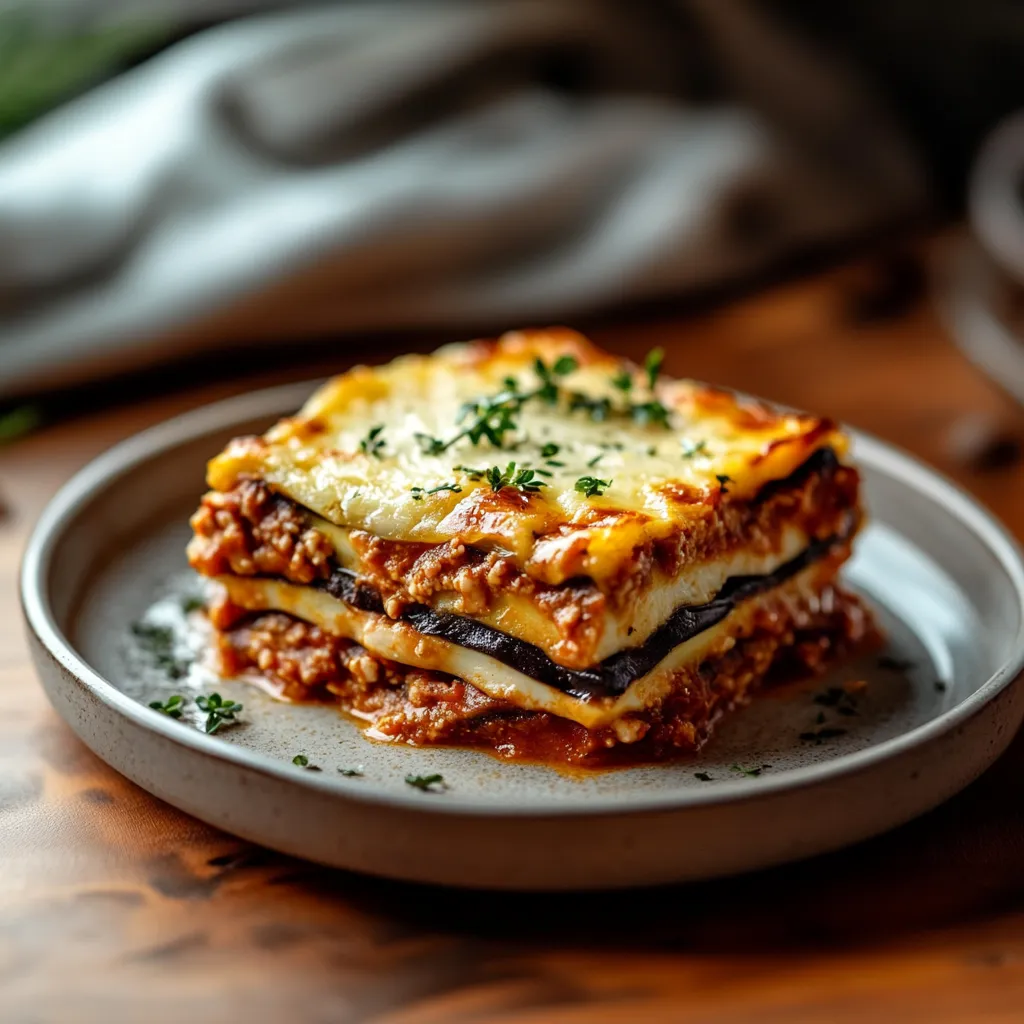 Pin it
Pin it
This hearty Greek eggplant moussaka turns simple ingredients into a delicious, multi-layered treat that'll make you feel like you're dining at a small taverna by the Greek coast. The smooth, velvety béchamel sits on top of soft eggplant and richly spiced meat sauce, making a meal that works just as well for guests as it does for family suppers.
I picked up this dish at a cooking workshop in Santorini a while back, and now it's my favorite way to bring back those wonderful Greek holiday feelings. The biggest cooking win I've ever had was when my Greek-American neighbor told me it reminded her of her grandma's cooking.
What You'll Need
- Eggplants: Go for ones that feel heavy with shiny, unblemished skin. The best picks have bright green stems and good weight in your hand.
- Ground beef or lamb: Lamb gives you that real Greek taste, but beef works great too. An 80/20 fat mix gives the juiciest results.
- Onion and garlic: These form the tasty base of your meat mixture. Pick onions that don't have any soft spots.
- Diced tomatoes: San Marzano ones taste amazing, but any good canned tomatoes will do the job.
- Cinnamon: This warm spice sets Greek moussaka apart from Italian baked dishes.
- Dried oregano: Try to get Greek oregano for the most authentic flavor.
- Butter: Rich European style butter makes your sauce extra creamy.
- All purpose flour: You'll need this to make your sauce thick and smooth.
- Whole milk: Don't skimp here—full fat milk makes the tastiest sauce.
- Eggs: These make your béchamel richer and help it set nicely when baked.
- Nutmeg: Fresh grated gives your white sauce that special touch.
How To Make It
- Get Your Eggplant Ready:
- Lay out eggplant slices on baking sheets and sprinkle them well with kosher salt. Let them sit for 30 minutes to pull out the bitter juice. Don't skip this step—it keeps your dish from getting watery and bitter. After half an hour, you'll see tiny water drops on top. Dry each slice completely with paper towels. Brush olive oil on both sides, put them on baking sheets without touching, and bake at 400°F for exactly 20 minutes until golden but still firm.
- Fix Up the Meat Sauce:
- Get a deep, big pan really hot over medium high heat. Add your ground meat, breaking it into little bits with a wooden spoon. Let it cook without too much stirring so it gets nicely browned, about 5 minutes. Pour off extra fat, leaving about a tablespoon. Toss in your finely chopped onion with the browned meat and cook for 4 minutes until see-through but not brown. Add the minced garlic and cook just 30 seconds until you can smell it—don't let it burn. Pour in the diced tomatoes with their juice, then add oregano, cinnamon, salt and pepper. Turn heat down to medium low and let it bubble uncovered for 20 minutes, stirring now and then. The sauce should get much thicker. You can tell it's done when a spoon dragged through leaves a path that slowly fills in.
- Whip Up the Béchamel:
- In a pot, melt butter over medium heat until it bubbles but stays light colored. Sprinkle in flour and whisk non-stop for 2 minutes to cook away the raw flour taste. It should look like damp sand and smell a bit nutty. Keep whisking while you pour in warm milk bit by bit. Going slowly stops lumps from forming. Keep whisking for 5 to 7 minutes as the sauce thickens enough to coat your spoon. When you can draw a line on the back of a spoon and it stays, you're good. Take a small amount of hot sauce and slowly mix it into beaten eggs in a separate bowl to warm them up. Then gradually whisk this egg mix back into the pot. Add nutmeg and salt, whisking until everything's smooth. Your finished sauce should be thick, shiny and lump-free.
- Put It All Together and Bake:
- In a 9x13 inch baking dish, lay down half your roasted eggplant slices in one layer, slightly overlapping if needed to cover the bottom. Spoon all your meat sauce over the eggplant, smoothing it out evenly. Top with the rest of your eggplant slices. Pour your béchamel over everything, using a spatula to spread it into a smooth, even layer covering all the eggplant. Bake at 350°F for 45 minutes until the top turns golden brown and bubbles around the edges. Let it sit for at least 15 minutes before cutting so the layers can set properly.
 Pin it
Pin it
My grandma always told me the key to amazing moussaka was taking your time with the béchamel. She'd stand there slowly stirring for what felt like forever, but that extra care really makes it special. Whenever I smell that hint of cinnamon in the meat sauce, I'm right back in her little kitchen in Athens.
Prep Ahead Tricks
Moussaka is perfect for making ahead and honestly tastes better with time. You can put the whole thing together up to 24 hours before you plan to bake it and keep it covered in the fridge. Just let it sit out for 30 minutes before popping it in the oven. Or you can fully bake it, cool it down completely, and keep it in the fridge for up to 3 days. When you're ready to eat, reheat it covered with foil at 350°F for about 25 minutes until hot.
Different Ways It's Made
Ask any Greek family and they'll swear their moussaka recipe is the real deal. Up north in Greece, many cooks add layers of sliced potatoes along with the eggplant. Island versions might include zucchini or even artichoke hearts. In Cyprus, they love to add sliced halloumi cheese between the layers. Some modern Greek cooks now make meat-free versions with lentils or mushrooms, but still keep those classic spices.
What To Serve With It
Moussaka stands great on its own but goes wonderfully with simple sides. Try it with a fresh Greek salad just tossed with olive oil and lemon. Some crusty bread is perfect for soaking up the sauce. If you're having wine, a medium red like Agiorgitiko from Greece works beautifully. In warmer months, try it with a chilled rosé or slightly cooled light red wine.
 Pin it
Pin it
Moussaka brings together amazing flavor layers that'll take you straight to Greece—trust me, every bit of effort pays off!
Frequently Asked Questions
- → Can I use ready-made roasted eggplant?
Sure! Pre-roasted eggplant works. Just make sure it’s fully cooked and dry. If it seems watery, pat it down to keep the dish from being soggy.
- → Which meat works better, lamb or beef?
Lamb has a distinctive, traditional flavor that pairs well with the spices, but beef is a great alternative. Mixing lamb and beef half-and-half gives a balanced flavor too.
- → Why do I salt the eggplant first?
Salting not only removes bitterness but also pulls out extra moisture. This keeps the eggplant firm while baking and prevents a soggy dish. It also reduces oil absorption when roasting.
- → Can I make this ahead of time?
Absolutely, this dish is great for planning ahead. Assemble and refrigerate before baking (up to 24 hours), or bake fully and store for up to 3 days. The flavors often get better over time.
- → Why did my béchamel sauce split?
Curdling happens if the eggs are added to a base that’s too hot or cooked over high heat. Slowly temper your eggs by adding a little warm sauce to them first, then blend them into the béchamel while keeping the heat low and stirring constantly.
- → What goes well with moussaka?
Try it with Greek salad, crusty bread, or steamed veggies. Tzatziki offers a refreshing contrast. Start with spanakopita and finish with sweet baklava for a true Greek experience.
